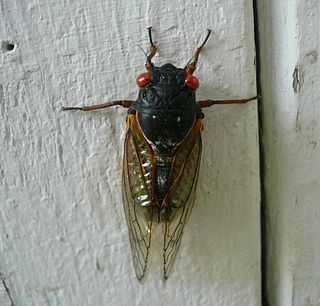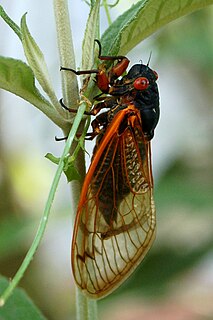
The cicadas are a superfamily, the Cicadoidea, of insects in the order Hemiptera. They are in the suborder Auchenorrhyncha, along with smaller jumping bugs such as leafhoppers and froghoppers. The superfamily is divided into two families, the Tettigarctidae, with two species in Australia, and the Cicadidae, with more than 3,000 species described from around the world; many species remain undescribed.

Brood X, the Great Eastern Brood, is one of 15 broods of periodical cicadas that appear regularly throughout the eastern United States. It has the greatest range and concentration of any of the 17-year cicadas.

Magicicada is the genus of the 13-year and 17-year periodical cicadas of eastern North America, consisting of seven species. Although they are sometimes called "locusts", this is a misnomer, as cicadas belong to the taxonomic order Hemiptera, suborder Auchenorrhyncha, while locusts are grasshoppers belonging to the order Orthoptera. Magicicada belongs to the cicada tribe Lamotialnini, a group of genera with representatives in Australia, Africa, and Asia, as well as the Americas.

Charles Lester Marlatt (1863–1954) was an American entomologist. Born in 1863 at Atchison, Kansas, he was educated at Kansas State Agricultural College, where he was assistant professor for two years. He is the person who introduced the ladybug insect Chilocorus similis into the United States to control the San Jose scale insect, which was first discovered in San Jose, California in 1880 by John Henry Comstock and named by him. Marlatt worked for the Bureau of Entomology, United States Department of Agriculture. In 1912 he was appointed chairman of the Federal Horticultural Board. He was president of the Entomological Society of Washington in 1897–98 and of the American Association of Economic Entomologists in 1899.

Brood XIII is one of 15 separate broods of periodical cicadas that appear regularly throughout the midwestern United States. Every 17 years, Brood XIII tunnels en masse to the surface of the ground, mates, lays eggs, and then dies off in several weeks.

Brood XIX is the largest brood of 13-year periodical cicadas, last seen in 2011 across a wide stretch of the southeastern United States. Periodical cicadas are often referred to as "17-year locusts" because most of the known distinct broods have a 17-year life cycle. Brood XIX is one of only three surviving broods with a 13-year cycle. It is also notable because it includes four different 13-year species, one of which was discovered in Brood XIX in 1998 by scientists listening to cicada songs.

Magicicada cassinii, sometimes called the 17-year cicada, Cassin's periodical cicada or the dwarf periodical cicada, is a species of periodical cicada. It is endemic to North America. It has a 17-year lifecycle but is otherwise indistinguishable from the 13-year periodical cicada Magicicada tredecassini. The two species are usually discussed together as "cassini periodical cicadas" or "cassini-type periodical cicadas." Unlike other periodical cicadas, cassini-type males may synchronize their courting behavior so that tens of thousands of males sing and fly in unison. The species was first described by Margaretta Morris. However, the specific name cassinii was in honour of John Cassin, an American ornithologist.

Magicicada septendecim, sometimes called the Pharaoh cicada or the 17-year locust, is native to Canada and the United States and is the largest and most northern species of periodical cicada with a 17-year lifecycle.

Thopha saccata, commonly known as the double drummer, is the largest Australian species of cicada and reputedly the loudest insect in the world. Documented by the Danish zoologist Johan Christian Fabricius in 1803, it was the first described and named cicada native to Australia. Its common name comes from the large dark red-brown sac-like pockets that the adult male has on each side of its abdomen—the "double drums"—that are used to amplify the sound it produces.

Massospora cicadina is a fungal pathogen that infects only 13 and 17 year periodical cicadas. Infection results in a "plug" of spores that replaces the end of the cicada's abdomen while it is still alive, leading to infertility, disease transmission, and eventual death of the cicada.

Aleeta curvicosta is a species of cicada, one of Australia's most familiar insects. Native to the continent's eastern coastline, it was described in 1834 by Ernst Friedrich Germar. The floury baker is the only described species in the genus Aleeta.
Magicicada tredecim is a 13-year species of periodical cicada, closely related to the newly discovered 13-year species Magicicada neotredecim, from which it differs in male song pitch, female song pitch preferences, abdomen color, and mitochondrial DNA. Both M. tredecim and M. neotredecim are closely related to the 17-year species M. septendecim, which was identified by Linnaeus in 1758; these three species are often grouped together under the name decim periodical cicadas.

Decim periodical cicadas is a term used to group three closely related species of periodical cicadas: Magicicada septendecim, Magicicada tredecim, and Magicicada neotredecim. M. septendecim, first described by Carl Linnaeus, has a 17-year life cycle; the name septendecim is Latin for 17. M. tredecim, first described in 1868, has a similar call and appearance but a 13-year life cycle; tredecim is Latin for 13. M. neotredecim, first described in 2000 by Marshall and Cooley in an article in the journal Evolution, is a 13-year species but otherwise much more similar to M. septendecim than to M. tredecim as shown by studies of DNA and abdominal color variation by Chris Simon and colleagues in a companion article in the same journal issue.

The Cassini periodical cicadas are a pair of closely related species of periodical cicadas: Magicicada cassinii, having a 17-year lifecycle, and Magicicada tredecassini, a nearly identical species with a 13-year lifecycle.

Magicicada tredecassini is a species of periodical cicada endemic to the United States. It has a 13-year lifecycle but is otherwise indistinguishable from the 17-year periodical cicada Magicicada cassini. The two species are usually discussed together as "cassini periodical cicadas" or "cassini-type periodical cicadas." Unlike other periodical cicadas, cassini-type males may synchronize their courting behavior so that tens of thousands of males sing and fly in unison.
Magicicada tredecula is a species of periodical cicada in the family Cicadidae. It is endemic to the United States. As its specific epithet implies, they emerge as adults once every thirteen years.

Brood II is one of 15 separate broods of Magicicada that appear regularly throughout the northeastern United States. Every 17 years, Brood II tunnels en masse to the surface of the ground, mates, lays eggs, and then dies off over the span of several weeks.
Brood XXII is a brood of 13-year periodical cicadas, last seen in 2014 in a geographic region centered on Baton Rouge, Louisiana, as well as other locations in southeast Louisiana and southwest Mississippi. Periodical cicadas are often referred to as "17-year locusts" because most of the known distinct broods have a 17-year life cycle. Brood XXII is one of only three surviving broods with a 13-year cycle. The next emergence of The Baton Rouge Brood is expected in 2027.
Brood XI was a brood of periodical cicadas that appeared regularly in the eastern United States. It was one of the smallest 17-year broods, consisting exclusively of the species Magicicada septendecim, and was historically restricted to areas of Connecticut, Massachusetts, and Rhode Island which appeared to be at the northern limit of the species' range. Brood XI has not been seen since its 1954 emergence and is now generally regarded as extinct.

Brood V is one of twelve extant broods of periodical cicadas that emerge as adults once every 17 years in North America. They are expected to appear in the eastern half of Ohio, the southwestern corner of Pennsylvania, the upper two-thirds of West Virginia less the Eastern Panhandle, far western Maryland, and some places in Virginia abutting West Virginia. Also included in Brood V is a population that emerges in Suffolk County, Long Island, New York. They last emerged in 2016, and their next appearance will be in 2033.















